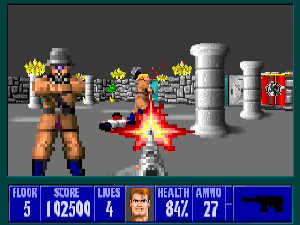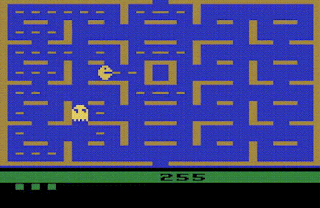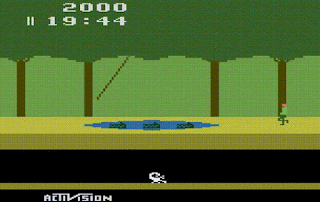Although it might be surprising at first to see art direction from the 1980s coming back, if you think about it long enough, it makes sense. According to the Entertainment Software Association, “the average gamer is 35 years old” (p. 4). The gamers of the 80s and early 90s are now adults, and many of the most popular games released in arcades and on home consoles during this time frame made heavy use of pixel art. There were few alternatives at the time – as we saw in the previous blog post, 3D graphics were still quite primitive and would be until the mid-to-late 90s.
Figure 1. Dino Run, by PixelJam Games. Notice the outline-free graphics (and thus bright colors) and also the simple shading (PixelJam Games, 2008).
Something you shouldn’t forget when comparing pixel art in modern games with that of 80s home consoles and computers is that our computers today are much less restricted graphically, in many different ways. The computers of yesteryear have to contend with their own hardware – they were restricted to low resolutions, few colors, and sometimes only a few colors in close proximity.
Figure 2. Example of the Commodore VIC-20’s graphical limitations on how many colors can appear in close proximity – notice the color of the dirt around the enemies (Murray, 2017).
On top of that, they had to contend with the monitors and video interfaces of the time, with color bleeding and artifacting a natural result of the then-current composite video connections.
Figure 3. Super Mario World for the SNES, zoomed in. On the left is an image over composite video, and on the right is the same image using a more modern YPbPr interface (HD Retrovision, LLC).
With modern computers, we don’t have to worry about any of these things – we get millions of colors in much higher resolutions now. This new-found ability to create games with 80s-style or 90s-style graphics without truly needing to worry about hardware limitations allows for a graphical style that appears old-fashioned but is, in reality, a blend of old and new.
Figure 4. Super Time Force Ultra. Despite the pixel art graphics, this game's system requirements far eclipse anything available in the 80s or 90s (Capybara Games, 2014).
That's not to say that all games eschew the limited palettes of yesteryear. Some games targetted towards modern platforms adopt graphical limits as a stylistic choice.
Figure 5. Tiny Dangerous Dungeons, an example of a game for modern computers that adopts the resolution and color palette of an original Nintendo Game Boy (Adventure Islands, 2013).
Nostalgia isn't the only factor in favor of a pixel art graphical style, however. Cost is a factor as well; pixel art is relatively quick and inexpensive these days. I would imagine that, for a game developer without an art budget or a particular talent for art, the prospect of picking up a 2D paint program to create pixel art is far less scary than the prospect of picking up a 3D modeling program. Anecdotally, I agree.
It's also quite possible that, as the demographic who grew up with these graphics ages, fewer people will have a sense of nostalgia for pixel art, and fewer people will appreciate it. In other words, pixel art might once again fall to the wayside; only time will tell.
References:
Entertainment Software Association. (2017). “Essential Facts about the Computer and Video Game Industry” [PDF Report]. Retrieved November 30, 2017 from http://www.theesa.com/wp-content/uploads/2017/09/EF2017_Design_FinalDigital.pdf
PixelJam Games. (April 30, 2008). Dino Run: Escape Extinction! [Video game]. Retrieved November 30, 2017 from http://www.kongregate.com/games/pixeljamgames/dino-run
Murray, D. (Jun 16, 2017). “VIC-20 Overload - Penultimate Cartridge, Pentagorat, & Planet X1” [Screenshot from video file]. Retrieved November 30, 2017 from https://www.youtube.com/watch?v=c5Fj8SALkbg
HD Retrovision, LLC. (n.d.). “SNES YPbPr Component Cable” [Image from webpage]. Retrieved November 30, 2017 from http://www.hdretrovision.com/snes/
Capybara Games. (August 25, 2014). Super Time Force Ultra [Image from webpage]. Retrieved November 30, 2017 from http://store.steampowered.com/app/250700/Super_Time_Force_Ultra/
Adventure Islands. (November 19, 2013). Tiny Dangerous Dungeons [Video game]. Retrieved November 30, 2017 from http://www.stencyl.com/game/play/22535





















